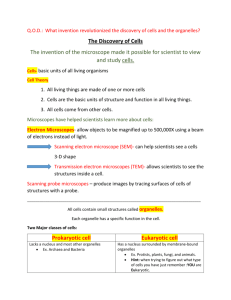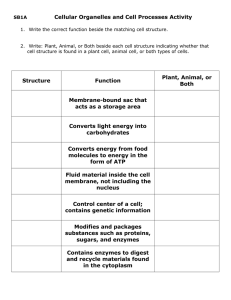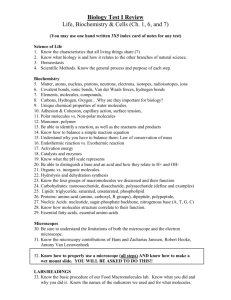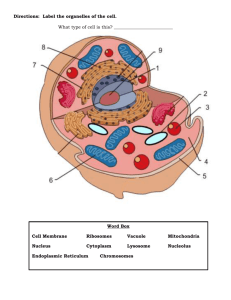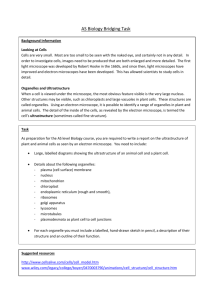TEM exercise updated and scanned June 2014
advertisement
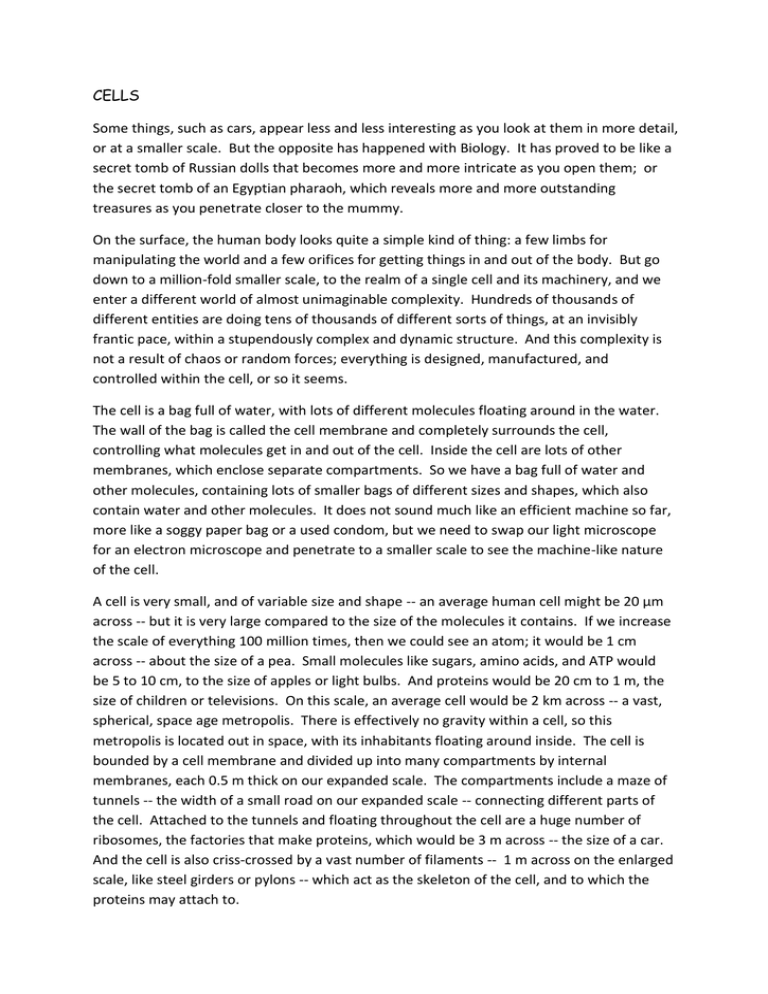
CELLS Some things, such as cars, appear less and less interesting as you look at them in more detail, or at a smaller scale. But the opposite has happened with Biology. It has proved to be like a secret tomb of Russian dolls that becomes more and more intricate as you open them; or the secret tomb of an Egyptian pharaoh, which reveals more and more outstanding treasures as you penetrate closer to the mummy. On the surface, the human body looks quite a simple kind of thing: a few limbs for manipulating the world and a few orifices for getting things in and out of the body. But go down to a million-fold smaller scale, to the realm of a single cell and its machinery, and we enter a different world of almost unimaginable complexity. Hundreds of thousands of different entities are doing tens of thousands of different sorts of things, at an invisibly frantic pace, within a stupendously complex and dynamic structure. And this complexity is not a result of chaos or random forces; everything is designed, manufactured, and controlled within the cell, or so it seems. The cell is a bag full of water, with lots of different molecules floating around in the water. The wall of the bag is called the cell membrane and completely surrounds the cell, controlling what molecules get in and out of the cell. Inside the cell are lots of other membranes, which enclose separate compartments. So we have a bag full of water and other molecules, containing lots of smaller bags of different sizes and shapes, which also contain water and other molecules. It does not sound much like an efficient machine so far, more like a soggy paper bag or a used condom, but we need to swap our light microscope for an electron microscope and penetrate to a smaller scale to see the machine-like nature of the cell. A cell is very small, and of variable size and shape -- an average human cell might be 20 µm across -- but it is very large compared to the size of the molecules it contains. If we increase the scale of everything 100 million times, then we could see an atom; it would be 1 cm across -- about the size of a pea. Small molecules like sugars, amino acids, and ATP would be 5 to 10 cm, to the size of apples or light bulbs. And proteins would be 20 cm to 1 m, the size of children or televisions. On this scale, an average cell would be 2 km across -- a vast, spherical, space age metropolis. There is effectively no gravity within a cell, so this metropolis is located out in space, with its inhabitants floating around inside. The cell is bounded by a cell membrane and divided up into many compartments by internal membranes, each 0.5 m thick on our expanded scale. The compartments include a maze of tunnels -- the width of a small road on our expanded scale -- connecting different parts of the cell. Attached to the tunnels and floating throughout the cell are a huge number of ribosomes, the factories that make proteins, which would be 3 m across -- the size of a car. And the cell is also criss-crossed by a vast number of filaments -- 1 m across on the enlarged scale, like steel girders or pylons -- which act as the skeleton of the cell, and to which the proteins may attach to. Mitochondria, the power stations of the cell, would be 100 m across -- the size of a power station -- and there would be roughly 1000 of them per cell. The nucleus, a vast spherical structure about 1 km across and a repository of aeons of evolutionary wisdom, broods over the cell. Imagine then that vastly expanded cell to be a metropolis floating in space, peopled by billions of small, specialised robots, doing thousands of different tasks, making, breaking, and moving trillions of other molecules in order to feed, power, inform, and maintain the cell. All the molecules are packed in tightly with very little free space, but movement is lubricated by water molecules that act like ball-bearings. So the cell is bigger compared with the molecules, but note that on this outsized scale, the human body would be 10 times the size of the earth itself, so there are there are an awful lot of cells in the body. However, that gives a rather static picture of the cell, which is in fact frantically busy. All the small molecules vibrate, rotating and colliding with their neighbours about a billion times per second. This incessant, shaking movement is powered by the body’s heat energy, the random motion of the molecules. And it is this random shaking that causes all of the small molecules to wander incessantly around the cell, held back only by the membranes and their tendency to stick to other molecules. It is a bit like an out-of-control pinball machine, with trillions of balls and speeded up a billion times. But there is effectively no friction and no gravity so it is a three-dimensional game. This random walk of all molecules, called diffusion, causes a molecule like ATP, to visit most parts of the cell every second, colliding with literally billions of other molecules. Larger molecules, like the proteins that are machinery of the cell, move at a more stately pace, but unless they are attached to the membranes or filaments, they still manage to vibrate and rotate roughly a million times per second. And an enzyme or other molecular machine performs its job of assembling, disassembling, or transporting other molecules about 1000 times per second.... from: The Energy of Life, Guy Brown (in the library) Cell Ultra-structure In this exercise, you will explore the ultra-structure of cells – in other words, the structures and organelles revealed by electron microscopes. By the end of this exercise you should be able to: o o o o o o Identify the organelles of plant and animal cells Describe the function of these organelles Calculate the actual size of an organelle based on its magnified image Explain the difference between TEM and SEM. Outline how and why specimens are prepared for viewing under an electron microscope. Explain the difference between magnification and resolution, and why EMs give much greater resolution than LMs. Exercise 1 o Fully label the drawings of an animal and plant cell, identifying all the organelles shown from the list below. o Nucleus o Nuclear envelope o Rough endoplasmic reticulum o Nuclear pore (RER) o Micro-villi o Smooth endoplasmic o Chromatin reticulum (SER) o Lysosomes o Golgi apparatus o Centrioles o Ribosomes o Cell surface membrane o Mitochondria o Nucleolus o Chloroplast o Cell wall Ultra-structure drawing of a representative animal cell Ultra-structure drawing of a representative plant cell Exercise 2 Match each organelle with its function from the following descriptions. Surrounds the nucleus. Separates the nuclear material from the cell cytoplasm. .......................................................................................................... Found in pairs in animal cells only. The attachment points for the spindle tubules during cell division. .......................................................................................................... Not found in all cells, this structure makes and transport lipids and steroids. .......................................................................................................... A complex of cellulose micro-fibrils rules running through a matrix of complex polysaccharides. Provides support to the cell. .......................................................................................................... Site of aerobic respiration. .......................................................................................................... Suicide bags. These structures are membrane-bound sacks that contain digestive enzymes which can be used to break down old organelles, or even the cell itself. .......................................................................................................... Contains the genetic information in the form of DNA. .......................................................................................................... Increase the surface area of the cell surface membrane. .......................................................................................................... Where polypeptides are packaged for export. The protein is modified by the addition of a carbohydrate chain to form a glyco-protein. .......................................................................................................... A series of membrane-bound cavities that act as the intracellular transport system. The London underground system of the cell. Studied with lumpy, granular things called ribosomes. .......................................................................................................... Site of photosynthesis. .......................................................................................................... A small hole that allows genetic information to pass from the nucleus to the cytoplasm. .......................................................................................................... Site of protein synthesis, where amino acids are joined together to form a polypeptide. .......................................................................................................... DNA combined with histone proteins for efficient packing. .......................................................................................................... Controls the movement of substances into and out of the cell. .......................................................................................................... A very dense chunk of DNA responsible for the manufacture of ribosomes. .......................................................................................................... All finished? Well done! Now it’s time to see if you can use this knowledge to interpret actual electron micrographs. For each of the following images, answer the questions below. Rat liver cell x 25,000 1) Identify structures A, B, C, D and H. 2) What is the actual width of the top B? Show your working. X 25,000 1) Identify B. 2) What kind of cell/tissue might need so many Bs???? X 200,000 This shows a close up of a particular organelle. Note the magnification!!!! 1) Identify E and F and the organelle. 2) What is the actual width of the organelle? X 16,000 Hmmm, this looks a bit different. Why might that be....? 1) Identify structures A, B, D, E, H and L. 2) The presence of L and D mean it must be what kind of cell??? X 33,000 You’ve not seen this organelle yet, but it’s pretty distinctive! 1) Identify structures G, E, L and O. 2) What is the actual width of O? X 25,000 1) This shows a close up of which organelle? 2) Identify C, G, and the material in the H region. 3) What is the actual width of C? X 21,000 Right, last one, and a bit of a challenge! If you work this one out, I’ll be very impressed. The image shows a transverse section through a rat neurone, with most of it being taken up with a very unusual cell. You should have encountered it at GCSE.... 1) What type of cell is shown and what is its function? 2) Identify L. 3) Identify C. Electron microscope theory Electron microscopes were developed because of the comparatively limited resolution of light microscopes. What does resolution mean? Why is resolution so important? Why does an electron microscope have a much higher resolution than a light microscope? Different types of electron microscope. There are two type of electron microscope – TEMs and SEMs. All the images showing cell ultrastructure were taken with a TEM. Find an amazing image taken with a SEM (Science Photo Library is a great place to search!). Download it, print it, and stick it in the space below. How can you instantly tell it’s an SEM? Outline the main differences between an SEM and a TEM. Preparing specimens for electron microscopes Electron microscopes fire electrons at the specimen. Explain why this means that each of the following are necessary when preparing and viewing specimens for the electron microscope. Specimens must be viewed in a vacuum. Specimens must be dehydrated. Specimens must be stained with horrible chemicals with scary names like osmium tetroxide, uranyl acetate and lead citrate. Specimens must be sliced very thin with something called a microtome (for TEMs). Specimens must be coated with gold particles (for SEMs). What is the main limitation of viewing biological specimens under an electron microsope?

